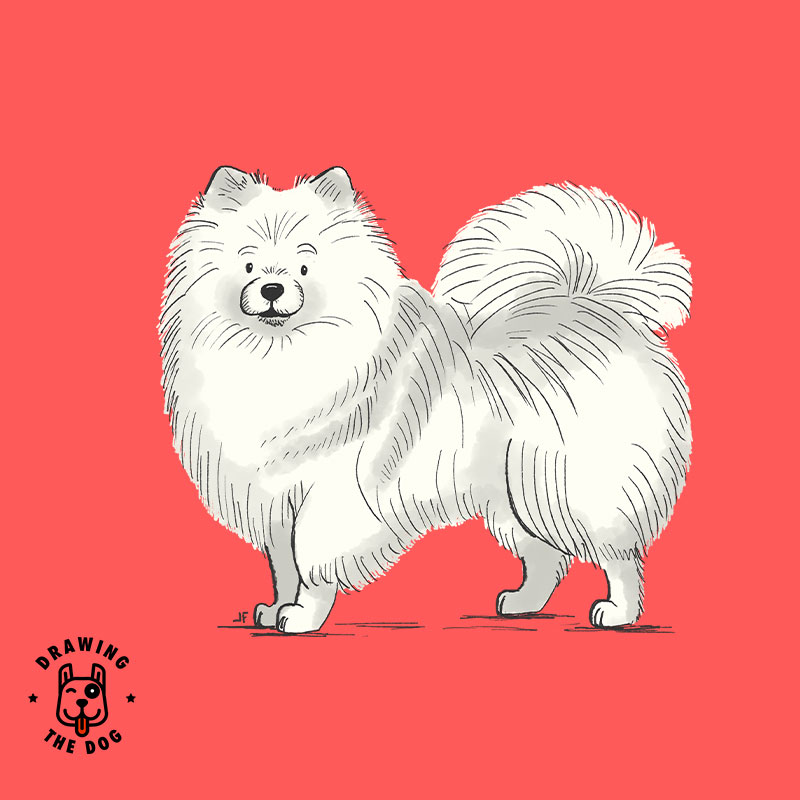Pomeranian 101:
A Guide To Poms

Everything you need to know about the adorable Pomeranian breed.
Pomeranians, affectionately called “Poms,” are one of the most beloved toy breeds worldwide. With their fluffy coats, bright eyes, and spirited personalities, these little dogs make a big impact! Whether you’re a new Pom parent, considering adopting, or just interested in learning more about them, this guide has everything you need to know about caring for a Pomeranian, from their grooming needs to personality quirks.
Check out our shop for high-quality pomeranian-themed wall art
Pomeranian Quick Facts
| Origin | Pomerania region (modern-day Poland and Germany) |
| Size | 20-28 cm (8-11 inches) |
| Weight | 1.8-3.5 kg (4-8 pounds) |
| Activity Level | Moderate |
| Barking/Howling Level | High |
| Good with Dogs | Yes, with proper socialization |
| Good with Kids | Yes, with supervision |
| Good with Cats | Yes, with supervision |
| Shedding | Moderate to heavy |
| Grooming Level | High |
| Training Level | Moderate (smart but can be stubborn) |
The History of Pomeranians
Pomeranians originated in the region of Pomerania, an area along the Baltic Sea in what is now Poland and Germany. These dogs are descendants of large, working Spitz breeds, bred down in size over the centuries to create today’s lap-sized companion. Interestingly, Queen Victoria popularized Pomeranians in the 19th century when she fell in love with the breed and bred them herself. The “Royal Pom” quickly became a staple of high society and has since become a global favourite.
Physical Characteristics of Pomeranians
Pomeranians are instantly recognizable for their distinctive “fox-like” faces, fluffy double coat, and lively expression. Despite their small size, they stand confidently with their heads held high, embodying their bold personalities. Poms have a double coat with a soft undercoat and a long, fluffy outer layer that comes in various colours, including orange, black, white, blue, and cream.
Temperament and Personality
Pomeranians have bold and spirited temperaments, often described as big personalities in small bodies. They’re incredibly loyal to their families and can be very protective, making them excellent watchdogs despite their small size. Poms are known for their curiosity, intelligence, and playful nature, though they can also be independent. Early socialization helps them become friendly with strangers, children, and other pets.
Intelligence and Trainability
These little dogs are intelligent and quick to learn, though they can also be a bit stubborn. Using positive reinforcement and treats makes training a Pomeranian enjoyable for both you and your pet. Basic commands, like sit, stay, and come, are typically easy for Poms to pick up, while housetraining may take extra patience. For owners interested in advanced training, Poms often excel in agility and obedience competitions, thanks to their natural intelligence and agility.
Exercise and Activity Needs
Pomeranians are active dogs that enjoy playing and exploring, but they don’t require a lot of exercise. A couple of short walks each day and some indoor playtime are usually enough to keep a Pom happy and healthy. Despite their energy, they tire quickly, so they’re perfect for owners who enjoy brief, daily activity but don’t have time for extended exercise routines.
Grooming Needs of Pomeranians
A Pomeranian’s double coat requires regular grooming to stay clean and free of tangles. Brushing at least 2-3 times per week is essential, and a full grooming session every few months will keep their coat in prime condition. Regular dental care is also important, as small breeds like Poms can be prone to dental issues. Regular baths, ear cleaning, and nail trimming are also part of a healthy grooming routine for your Pom.
Common Health Issues
Pomeranians are generally healthy but may be prone to certain genetic issues, including patellar luxation (knee problems), tracheal collapse, and dental disease. Regular check-ups with your vet are key to early detection and treatment. Be sure to watch for any signs of respiratory issues or joint discomfort, as these can sometimes arise due to their size and body structure.
Diet and Nutrition
Pomeranians should eat a balanced diet suited to their small size, generally divided into 2-3 small meals per day. High-quality dog food that’s specifically formulated for small breeds is recommended, as Poms need dense nutrition in small portions. Consult with your vet on portion sizes to prevent obesity, a common issue among small dog breeds.
Living with a Pomeranian
Thanks to their small size, Pomeranians adapt well to apartment living and don’t require a large home. They are sensitive to extreme temperatures, so ensure your Pom stays cool in the summer and warm in winter. A cosy bed, some toys, and a safe space to play will keep them comfortable.
Pomeranians and Other Pets
Pomeranians can get along well with other dogs, cats, and even smaller pets if socialized early. Their confident nature can sometimes make them a bit bossy, especially around larger dogs. Introductions with other pets should be done gradually to ensure a positive relationship.
Pomeranian Puppies
Raising a Pomeranian puppy is a fun and rewarding experience. However, it’s important to begin training and socialization early. These tiny puppies have a lot of energy and curiosity, so provide plenty of toys, supervised play, and frequent potty breaks. Puppy-proofing your home is essential, as their small size makes them prone to slipping into tight spaces or accidentally injuring themselves.
Selecting a Pomeranian Breeder
If you’re purchasing a Pomeranian puppy, it’s crucial to find a reputable breeder. Look for a breeder who is knowledgeable about the breed’s health concerns and temperament. A responsible breeder will provide health clearances and information about the puppy’s parents. Avoid breeders who cannot provide references or who have poor facility conditions.
Adopting a Pomeranian
Adopting is a wonderful way to bring a Pomeranian into your life while giving a home to a dog in need. Pomeranian rescues and local animal shelters often have Poms available for adoption, including adults and seniors who need loving homes. Adopting may also be more cost-effective than purchasing a puppy and often includes initial vaccinations and spaying/neutering.
Common Behavioral Issues
Pomeranians may exhibit common behavioural issues, including excessive barking, resource guarding, and separation anxiety. Consistent training and socialization help mitigate these behaviours. For barking, consider teaching a “quiet” command, and if your Pom shows signs of separation anxiety, gradually practice leaving them alone for short periods.
Training Tips and Tricks
Training a Pomeranian can be fun if you incorporate their natural intelligence and love of attention. Stick with short, consistent training sessions and use positive reinforcement. Try basic tricks like “paw” or “spin,” which are easy to teach and give your Pom a chance to show off their cleverness.
Pomeranian Show Dogs
Pomeranians often perform well in dog shows due to their unique appearance and confident nature. If you’re interested in showing your Pom, consider connecting with a local dog show club or organization to learn more about grooming standards, show handling, and what judges look for in a winning Pom.
Traveling with a Pomeranian
Traveling with a Pomeranian is easy due to their small size. They typically fit comfortably in airline-approved carriers and adapt well to new environments with some reassurance. Be sure to pack essentials like a water bottle, snacks, and a travel bed, and always check with the airline for pet policies.
Fun Activities for Pomeranians
Poms love activities that engage their brains, so games like hide-and-seek and puzzle toys are perfect for them. A gentle game of fetch or a walk around the block will also satisfy their playful energy. Indoor agility courses are another great way to keep them mentally and physically active.
Cost and Budgeting
The cost of owning a Pomeranian includes food, grooming, veterinary care, and accessories. Plan for regular expenses such as food and annual check-ups, as well as occasional grooming appointments if you prefer professional services.
Choosing Accessories and Essentials
When selecting accessories, look for items sized specifically for small dogs. A soft harness, small bed, and toys made for tiny mouths are ideal. Consider a carrier bag for easy travel, especially if you’re taking your Pom to a busy area or a long walk.
Art Prints Featuring Pomeranians
If you’re a proud Pomeranian parent or simply love the breed, consider adding art prints or Pomeranian-themed gifts to your home. Art prints capturing the essence of Poms make lovely decor and showcase your love for the breed. Visit our online shop for custom wall art, gifts, and more, all inspired by Pomeranian dogs!
Pomeranian Popularity in Media
Pomeranians have become famous through movies, TV shows, and social media, with famous Poms like Boo capturing hearts around the world. Their adorable looks and feisty personality have made them beloved icons in popular culture.
Pomeranians for Families and Singles
Pomeranians adapt well to various households, including families with children and single-person homes. They require supervision around young kids due to their small size, but they tend to bond well with all family members and make loyal companions.
Art Prints Featuring Pomeranians
If you’re a proud Pomeranian parent or simply love the breed, consider adding art prints or Pomeranian-themed gifts to your home. Art prints capturing the essence of Poms make lovely decor and showcase your love for the breed. Visit our online dog art shop for custom wall art, gifts, and more, all inspired by Pomeranian dogs!
Frequently Asked Questions
What makes Pomeranians so special?
Pomeranians are beloved for their playful personalities, unique looks, and adaptability. They bond closely with their owners and bring joy with their feisty, spirited nature.
How much exercise does a Pomeranian need?
Pomeranians don’t require extensive exercise; short daily walks and indoor playtime are generally sufficient.
Are Pomeranians good with other pets?
Yes, with proper socialization, Pomeranians can get along well with other dogs and cats.
How much grooming do Pomeranians need?
Their double coat requires regular brushing and occasional grooming sessions to stay free of mats and tangles.
Are Pomeranians easy to train?
They are intelligent and eager to please but may have a stubborn streak, so patience and consistency are key.
How can I reduce a Pomeranian’s barking?
Teaching commands like “quiet” and ensuring they have plenty of physical and mental stimulation can help reduce excessive barking.
Conclusion
Pomeranians bring endless joy and personality to any home. From their spunky nature to their iconic fluffy coats, they’re a breed that’s as fun as they are unique. If you’re ready to welcome a Pomeranian into your life, remember to be patient, provide plenty of affection, and enjoy the adventure with your new best friend.
More Reading:
American Kennel Club: Pomeranian







